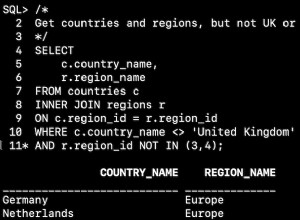Uma opção:envie a lógica para verificar se uma coluna está sendo rastreada no procedimento f_log e, em seguida, passe por todas as colunas.
Por exemplo, se sua track_Table contém valores (table_name, column_name, allow) para cada coluna que você deseja rastrear, algo assim
CREATE OF REPLACE PROCEDURE f_log( p_id varchar2
,p_table_name varchar2
,p_column_name varchar2
,p_old_val varchar2
,p_new_val varchar2)
as
l_exists number;
cursor chk_column_track IS
SELECT 1
FROM track_TABLE
WHERE upper(TABLE_NAME) = upper(p_table_name)
AND UPPER(column_name) = upper(p_column_name)
AND upper(allow) = 'Y';
begin
open chk_column_track;
fetch chk_column_track into l_exists;
if chk_column_track%found then
--do the insert here
end if;
close chk_column_track;
end;
/
CREATE OR REPLACE TRIGGER trg_TRACK
AFTER INSERT OR UPDATE OR DELETE ON ABC
FOR EACH ROW
DECLARE
n_id varchar(50);
BEGIN
n_id := NVL(:old.id, :new.id);
-- send all of the values to f_log and have it decide whether to save them
f_log(:old.id,'COL1',:old.col1,:new.col1);
f_log(:old.id,'COL2',:old.col2,:new.col2);
f_log(:old.id,'COL3',:old.col3,:new.col3);
...
END;
E pelo amor de Deus, coloque em maiúsculas os valores em sua track_table na inserção para que você não precise colocar UPPER() nos valores armazenados, tornando inútil qualquer índice nesses valores!
Agora, isso consumirá alguns recursos verificando cada nome de coluna em cada operação, mas se você não estiver executando grandes volumes, poderá ser gerenciável.
Caso contrário, você precisará de uma solução mais elegante. Como aproveitar o poder das coleções e a cláusula TABLE() para fazer a pesquisa track_table em uma operação em massa. Tenha em mente que estou longe do meu banco de dados no momento, então não testei este código.
CREATE OR REPLACE TYPE t_audit_row AS OBJECT (
p_table_name varchar2(30)
,p_column_name varchar2(30)
,p_id varchar2(50)
,p_old_val varchar2(2000)
,p_new_val varchar2(2000)
);
CREATE OR REPLACE TYPE t_audit_row_table AS TABLE OF t_audit_row;
CREATE OR REPLACE PROCEDURE f_log (p_audit_row_table t_audit_Row_table)
AS
begin
-- see how we can match the contents of the collection to the values
-- in the table all in one query. the insert is just my way of showing
-- how this can be done in one bulk operation. Alternately you could make
-- the select a cursor and loop through the rows to process them individually.
insert into my_audit_log (table_name, column_name, id, old_val, new_val)
select p_table_name
,p_column_name
,p_id
,p_old_val
,p_new_val
FROM track_TABLE TT
,table(p_audit_row_table) art
WHERE tt.TABLE_NAME = art.p_table_name
AND tt.column_name = art.p_column_name
AND tt.allow = 'Y';
end;
/
CREATE OR REPLACE TRIGGER trg_TRACK
AFTER INSERT OR UPDATE OR DELETE ON ABC
FOR EACH ROW
DECLARE
l_id varchar(50);
l_audit_table t_audit_row_table;
BEGIN
l_id := NVL(:old.id, :new.id);
-- send all of the values to f_log and have it decide whether to save them
l_audit_table := t_audit_row_table (
t_audit_row ('ABC','COL1',l_id, :old.col1, :new.col1)
,t_audit_row ('ABC','COL2',l_id, :old.col2, :new.col2)
,t_audit_row ('ABC','COL3',l_id, :old.col3, :new.col3)
,...
,t_audit_row ('ABC','COLn',l_id, :old.coln, :new.coln)
);
f_log(l_audit_table);
end;
/




